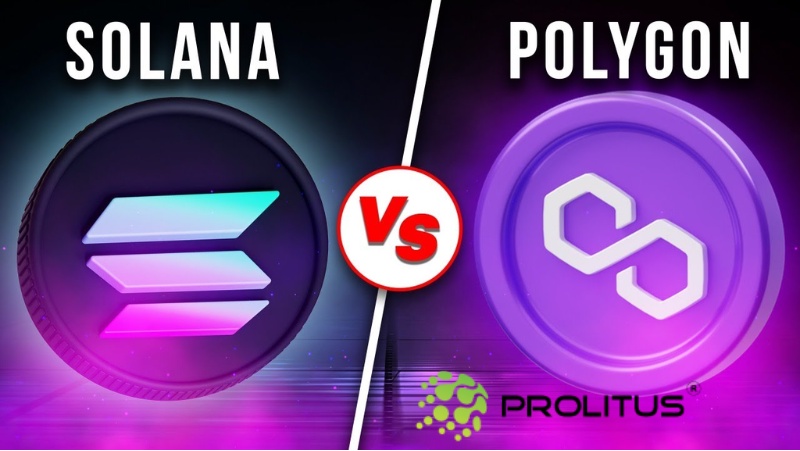Introduction:
Blockchain technology has revolutionized various industries, but the issue of scalability has remained a significant challenge. In response, innovative solutions like Polygon and Solana have emerged as Layer 2 scaling options, offering faster transactions and enhanced scalability. In this article, we will explore the features, use cases, and future prospects of both Polygon and Solana, comparing these two powerhouses in the blockchain space.
Understanding Polygon:
Polygon, previously known as Matic Network, has gained considerable traction as a Layer 2 scaling solution for Ethereum. Its architecture enables high-speed, low-cost transactions while maintaining compatibility with Ethereum's smart contracts. Polygon achieves this by utilizing various scaling techniques, such as sidechains, plasma chains, and rollups. Its interoperability allows developers to seamlessly integrate with the Ethereum ecosystem, providing a wide range of benefits.
Exploring Solana:
Solana has quickly risen to prominence as a high-performance blockchain platform capable of handling thousands of transactions per second. Its unique architecture, based on a proof-of-history consensus mechanism, facilitates lightning-fast transaction processing. Solana's scalability is achieved by utilizing a network of interconnected nodes that parallelize transaction processing. This approach results in significantly reduced transaction fees and near-instant confirmation times.
Comparing Polygon and Solana:
a. Scalability: Both Polygon and Solana address the scalability challenge, albeit through different approaches. Polygon enhances Ethereum's scalability by leveraging Layer 2 solutions, while Solana's architecture is designed for high throughput from the ground up. While both platforms excel in scaling, Solana's performance stands out for its ability to process a vast number of transactions in parallel, making it particularly suitable for applications requiring high transaction volumes.
b. Interoperability: Polygon and Solana enable interoperability with other blockchains, but Polygon's compatibility with Ethereum grants it an edge. By building on Polygon, developers can access Ethereum's vast ecosystem and benefit from the network effects. Solana, on the other hand, focuses on its own blockchain ecosystem, providing a robust environment for developers to build decentralized applications (DApps) without relying on other networks.
c. Transaction Speed: Both Polygon and Solana excel in transaction speed compared to their counterparts. Polygon offers fast confirmations and low transaction fees, providing an efficient environment for users and developers. Solana, however, takes transaction speed to new heights, boasting near-instant confirmation times, making it ideal for real-time applications and high-frequency trading.
d. Developer Friendliness: Both platforms have invested in providing developer-friendly tooling and documentation. Polygon offers a smooth transition for Ethereum developers, as they can utilize existing knowledge and tools. Solana, although relatively newer, has an active and supportive developer community, offering a growing set of resources and libraries to simplify development on the platform.
Use Cases and Adoption:
Polygon has found extensive use in decentralized finance (DeFi), non-fungible tokens (NFTs), and gaming applications. Prominent projects such as Aave, Sushiswap, and Decentraland have embraced Polygon for its scalability and low transaction costs. Solana has gained traction in the DeFi space as well, with projects like Serum and Raydium utilizing its high throughput to enable efficient trading and liquidity provision.
Challenges and Future Outlook:
While both Polygon and Solana have made significant strides, they face challenges in maintaining their growth trajectories. Polygon needs to address potential security concerns with its Layer 2 solutions, while Solana must ensure decentralized governance and continued network stability. Looking ahead, both platforms are actively working on upgrades and improvements to enhance scalability, interoperability, and developer experience.
Conclusion:
Polygon and Solana offer powerful solutions to the scalability problem in blockchain networks. Polygon's integration with Ethereum provides a seamless experience for Ethereum developers, while Solana's blazing-fast performance sets it apart for high-throughput applications. As the blockchain industry continues to evolve, the choice between Polygon and Solana will depend on specific project requirements. With their impressive features and growing ecosystems, both platforms have the potential to shape the future of blockchain technology.
In conclusion, Polygon and Solana exemplify the advancements in Layer 2 scaling solutions, catering to different needs within the blockchain space. As developers and businesses continue to explore scalable blockchain solutions, Polygon and Solana stand as formidable options, driving innovation and unlocking new possibilities.


No comments yet